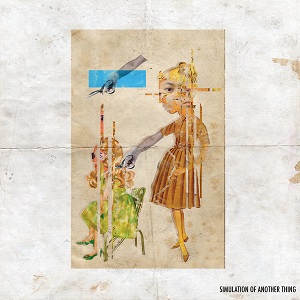 San Diego’s Steve Flato has remarkable and unpredictable range—from structured harsh noise (Mara’s Daughters) and hallucinogenic sine assaults (Salon de Flato) to mathematical ambience (This Is Our Last Cry Before Our Eternal Silence), and now, with Simulation of Another Thing, orchestrated soundtracks. Recorded with a trio featuring trombone, tuba, and French horn, Simulation blends melody, voice, field recordings, and improvised noise across three varied and affective songs (with an emphasis on the sinister). It comes in at a concise 30 minutes, but Flato packs a lot of great performances and unusual choices into that space, including one that combines the reassuring voice of a hairdresser with the steady pulse of a drum machine.
San Diego’s Steve Flato has remarkable and unpredictable range—from structured harsh noise (Mara’s Daughters) and hallucinogenic sine assaults (Salon de Flato) to mathematical ambience (This Is Our Last Cry Before Our Eternal Silence), and now, with Simulation of Another Thing, orchestrated soundtracks. Recorded with a trio featuring trombone, tuba, and French horn, Simulation blends melody, voice, field recordings, and improvised noise across three varied and affective songs (with an emphasis on the sinister). It comes in at a concise 30 minutes, but Flato packs a lot of great performances and unusual choices into that space, including one that combines the reassuring voice of a hairdresser with the steady pulse of a drum machine.
Album opener "Realistic Binaural Haircut" stands out as one of the more unusual and satisfying tracks Steve has ever recorded. Its primary elements are a burbling synth, a plodding tom-tom rhythm, several comedic horn sequences, and a hairdresser who whispers in a semi-seductive tone about highlights, layers, and split ends. She moves from left to right in the stereo, recommending hair colors and magazines while a steady pulse of electronic signals seeps into the mix. At the same time, a current of brassy tones burble into the foreground like an excited Shriner parade drawing interlocked figure-eights in the air. If the rest of the song, which jumps into double time halfway through, didn’t sound sound so intense, "Binaural" might come across like a joke. Instead, it revels in a Matmos-like confusion of driving noise and playful improvisations, both severe and mischievous.
"Dissonance Quartet" and "Simulation of a Thing at Owl Creek Bridge" tread on more somber ground. They’re moodier and twilit, especially "Dissonance," with its cavernous string melodies and spaced-out synths. There’s a touch of film noir about it, a romantic evocation of silhouetted detectives and half-seen movements that makes the piece feel tailor-made for the movies. "Simulation" travels further into expressionistic territory with steady drones and textured, almost empty field recordings. More like a Rorschach test than a cinematic score, the horns, faded environmental sounds, and electronic miscellany that populate its middle portion are porous and flexible, or hard and reflective, but definitely material, definitely bearing weight. The particular thing at Owl Creek Bridge that the piece is meant to simulate stays out of sight. Rather than clarify its qualities, Steve Flato chooses to obscure them, inviting his audience to wander into the mystery a little ways. Besides, there need not be a thing at Owl Bridge for the song to work (and Ambrose Bierce readers will probably read the reference differently anyway). By the time the album’s done, the listener has seen and felt its presence too, not as a definite thing, but as an enigma.
samples:
 
Read More

